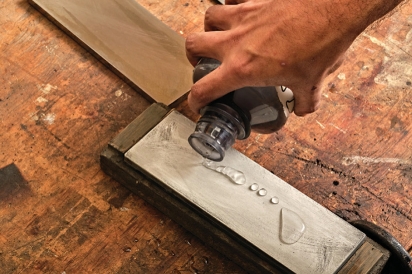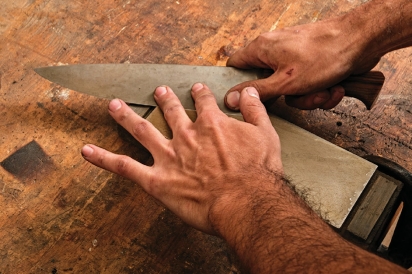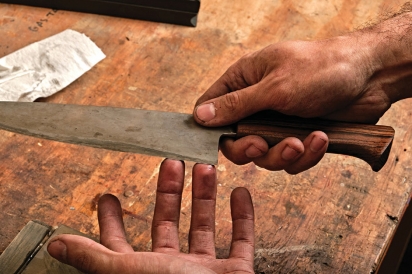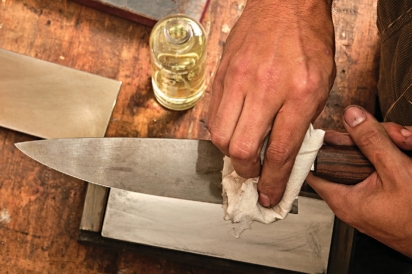Hone Your Knife Care Skills
YOU’VE SELECTED THE right knife made out of the best material. Now you’ll want to take care of it properly.
For culinary knifemaker Niko Nicolaides, the process begins with a 1200-grit diamond stone. 1
“I like diamond for initial sharpening of knives I’m working on and for initial sharpening and for refinishing and sharpening an edge,” he says, adding that “they’re simple and they’re aggressive and make sharpening really quick. They’re easy to learn on and they’re not as expensive as trying to buy natural.”
2 With the help of a little bit of plain tap water, he starts very slowly working at the heel, and slowly sharpening that up. He explains with sharpening, you’re working to feel a burr form, which is eroding the material on one side of the edge. A burr is a bit of metal along the knife edge or the tip of the knife that either stands on one side or the other. It’s identifiable as the raised edge or small pieces of material that remain attached to a knife after sharpening.
Where to buy knives during the holidays
Detroit Knife Company
detroitknifecompany.com
Nicolaides Knives
nicolaidesknives.com
Rapid River Knifeworks
rapidriverknifeworks.us
He likens it to drilling a hole: “You’ll notice like the second the bit breaks through the other side that it makes sharp edges.
“That’s essentially the same thing we’re doing with a knife edge. We are just doing it on a smaller, intentional scale.”
3 He works on one side, setting up that burr, and then goes to the other side.
“You can feel a little bit of an edge with your fingertips. And if you’re sharpening on one side, you’re going to go to the side that is up and take your fingers and slowly feel just towards the edge to see if they cut.” 4
He does a couple of passes over the whole side, then flips it over to repeat the process to see where the burr has formed to make sure sharpening is done evenly.
“You want to hold constant pressure and work in the same angle and at the same time following that line of your edge,” he advises. “You don’t want to oversharpen like around your tip or do the same at the heel.”
The next steps are polishing and stropping; doing these frequently will help maintain your edge between sharpenings.
To polish, he moves up to a 2000 grit stone; the high grit makes it shine. 5 He uses a Shapton glass, which is a synthetic stone. He does a couple of passes using slow, deliberate strokes over the stone to clean up the edge itself.
The final step is stropping, which will help achieve the finest edge possible. Stropping removes the microscopic-level inconsistencies of the edge, ensuring your knife has a razor-sharp edge.
“Stropping is where we’re going to break that burr that we’ve been folding back and forth off the edge completely. So when you’re sharpening, you’re constantly eroding that edge and pushing it from one side to the other.”
Using a polished piece of leather, he pulls away from the edge and slowly tries to get bits of burr to pop off. “When you’ve got it, there should be little steel hairs that come off the edge,” he says.
Nicolaides says after the knife has been wet during the process, you will need to use some oil to maintain it. 6 A special kind of knife oil is not necessary, he says. Something as simple as mineral oil will work but he doesn’t recommend using oils used for cooking such as olive oil.
Dorothy Hernandez is a freelance journalist who has contributed to the Chicago Sun-Times, NPR, Midwest Living, Eater, Thrillist and more national and local publications.











